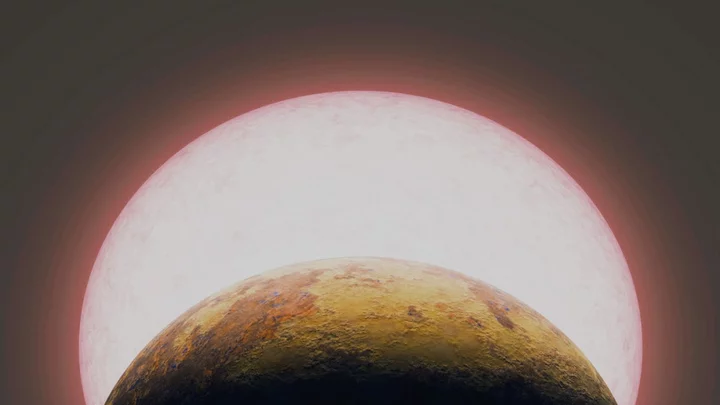Scientists have made giant leaps honing the techniques for finding worlds outside of Earth's solar system, detecting new ones on the order of hundreds every year.
The number of confirmed exoplanets — planets orbiting stars other than the sun — has risen to 5,438, with 9,600 more candidates under review. Most of these are in the Milky Way, though scientists think they discovered the first planet within another galaxy two years ago.
Statistically speaking, the growing tally only scratches the surface of planets believed to be in space. With hundreds of billions of galaxies, the universe likely teems with many trillions of stars. And if most stars have one or more planets around them, that's an unfathomable number of worlds.
What scientists are learning is that alien worlds are like snowflakes, each with their own distinct combinations of characteristics. There are water worlds, planets with multiple sunsets, volcanic worlds spewing lava, and some in unexpected shapes like a football.
With the new James Webb Space Telescope, getting to know these worlds should become profoundly easier. The premier space observatory will spend about 25 percent of its time studying exoplanets. Knowing what's in another planet's atmosphere can tell scientists a lot about a world, including whether it could be hospitable to life.
SEE ALSO: NASA's finally talking about UFOs with Americans. Here's what they said.This TRAPPIST planet couldn't hack it
The rocky exoplanet about 41 light-years away doesn't appear to have an atmosphere and is a toasty 450 degrees Fahrenheit. Credit: NASA / ESA / CSA / Joseph Olmsted (STScI) illustrationWhen astronomers conducted a Webb study of TRAPPIST-1B this year, they found its size was likely the closest thing it had in common with Earth.
The rocky exoplanet about 41 light-years away doesn't appear to have an atmosphere and is a toasty 450 degrees Fahrenheit, according to a paper published in the journal Nature. So, just the right temperature for a dystopian book-burning future, anyone?
Scientists have eagerly awaited an opportunity to study the TRAPPIST-1 solar system, a family of seven Earth-size planets orbiting a red dwarf, a tiny but violent type of star commonly found in the Milky Way. They've speculated that one or two of the TRAPPIST worlds, discovered six years ago, could be habitable.
Though TRAPPIST-1B isn't likely to support life, researchers are just getting started on their studies of this intriguing star system. They are looking forward to studying some of the other planets, particularly its neighbor TRAPPIST-1E, the fourth from the star. It is thought to be the right distance to allow liquid water to form into lakes and oceans on the planet's surface.
An Earth twin that hints at an atmosphere
GJ 486b is a rocky exoplanet about 30 percent larger than Earth, orbiting a red dwarf star every 1.5 days. Credit: NASA / ESA / G. Bacon (STScI) illustrationAstronomers are taking a closer look at another rocky exoplanet, GJ 486 B, relatively close to our solar system at just 26 light-years away in the constellation Virgo. Discovered two years ago, it's about 30 percent larger than Earth, orbiting a red dwarf every 1.5 days.
Despite being so close to its host star and having a scorching temperature of about 800 degrees Fahrenheit, the planet shows signs of having water vapor — a hint that the alien world may have an atmosphere swaddling the planet. And atmospheres are critical for shielding a planet from ultraviolet solar radiation, maintaining habitable temperatures, and creating the pressure needed for liquid water.
But could it be nothing more than a mirage?
Another possible explanation for the vapor detected by Webb is that water is coming from the outer layer of the nearby star, cooler than the sun, and not from the planet at all. Scientists will need more observations to determine if the exoplanet indeed has an atmosphere and how much water is present. Without an atmosphere, life — at least the type able to flourish on Earth — wouldn't exist.
Water vapor has been discovered on gassy exoplanets before, but never for a rocky or terrestrial planet akin to Earth, Mars, Mercury, and Venus.
A shadowed lava world
Astronomers have found an exoplanet that could be teeming with volcanoes. Credit: NASA’s Goddard Space Flight Center / Chris Smith (KRBwyle) illustrationWant more science and tech news delivered straight to your inbox? Sign up for Mashable's Light Speed newsletter today.
An intriguing world sits just on the cusp of the so-called Goldilocks zone, the region around a host star where it is not too hot and not too cold for liquid water to exist on the surface of planets.
That's, in part, why scientists are interested in LP 791-18 D, a temperate world about the size of Earth orbiting a small red dwarf star 90 light years away in the southern constellation Crater.
But if it sounds like paradise, consider that the exoplanet is packed with gushing volcanoes, with half the planet in perpetual daylight while the other half sits in constant darkness. These extreme conditions may combine to provide the necessary ingredients for the planet to have an atmosphere. Many planetary scientists believe volcanic activity is key for a life-sustaining world because the release of gasses during an eruption contributes to the atmosphere and can help a planet maintain moderate temperatures.
Astronomers want to get observation time on the Webb telescope to conduct an atmospheric study of the exoplanet. Discoveries of water and methane, for example — important ingredients for life as we know it — could be signs of potential habitability or biological activity.
A planet with terrifying sand clouds
The James Webb Space Telescope is helping astronomers study an unusual planet 40 light-years from Earth. Credit: NASA / ESA / CSA / Joseph Olmsted (STScI) illustrationThe clouds over a newly discovered world 40 light-years from Earth swirl with sizzling, gritty flecks of sand.
On VHS 1256 B, it's a perpetual, blistering sandstorm. Up in the clouds, temperatures reach a scorching 1,500 degrees Fahrenheit. And when the clouds get too heavy, rainstorms likely pelt the planet with the sandy mixture, astronomers say.
Though the exoplanet's days are only two hours shorter than ours, it takes 10,000 Earth-years to make a complete trip around its two stars. A NASA Twitter account described it as "Tatooine-like," referencing Luke Skywalker's desert planet in Star Wars, which had twin sunsets. Given how far away the world is from its stars — about four times farther than Pluto is from the sun — their light wouldn't shine that bright.
Astronomers say the observations of the exoplanet thus far are thrilling because they illustrate how otherworldly clouds could be totally different from the water vapor clouds of Earth.









